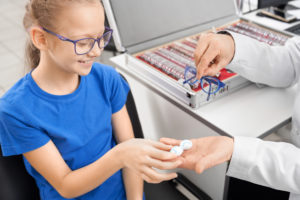June 16, 2020
 SAN RAMON, Calif. —Two scientific papers being presented as part of the ARVO (Association for Research in Vision and Ophthalmology) 2020 virtual conference proceedings provide eye care professionals (ECPs) with new insights to aid contact lens-based myopia management with children. Both can be accessed from the ARVO Media library catalog within ARVOLearn. Abstracts will be published in Investigative Ophthalmology & Visual Science next month.
SAN RAMON, Calif. —Two scientific papers being presented as part of the ARVO (Association for Research in Vision and Ophthalmology) 2020 virtual conference proceedings provide eye care professionals (ECPs) with new insights to aid contact lens-based myopia management with children. Both can be accessed from the ARVO Media library catalog within ARVOLearn. Abstracts will be published in Investigative Ophthalmology & Visual Science next month.
ReCSS Study Examines Safety of Pediatric Soft Contact Lens Wear
Robin Chalmers, OD, FAAO, Principal Investigator for the ReCSS study (Retrospective Cohort Study of Safety of Pediatric Soft Contact Lens Wear),1 led the effort on behalf of CooperVision as part of its FDA approval for MiSight 1 day contact lenses.* The study retrospectively reviewed 4,611 clinical charts from 782 children across seven geographically and ethnically diverse private eye care practices in the United States and from 181 children in two randomized longitudinal clinical trials.
The record review included any clinical visits of children through age 16 who were first fit with soft contact lenses when 8 to 12 years old. Clinical records involving adverse events were assessed and classified by an independent expert medical panel. The annualized rate of infiltrative adverse events was very low (0.66 percent/year with a 95 percent CI 0.39–1.05) as was the annualized rate of contact lens papillary conjunctivitis (0.48 percent/year with a 95 percent CI 0.25-0.82). The study estimated a microbial keratitis rate of 7.4/10,000 years (95 percent CI 1.8–29.6) in soft contact lens wearers aged 8-16 years, comparable to the estimated rates in adult wearers.
“Parents often ask eye care practitioners if children can safely wear contact lenses. This work adds to the substantial evidence of safe soft contact lens wear in children and should help ECPs reassure families as they consider myopia management options,” said John McNally, OD, FAAO, one of the study’s authors and Senior Director, Clinical Research at CooperVision.
Population-Based Centile Analysis Affirms MiSight 1 day* Contact Lens Clinical Trial Outcomes
Ian Flitcroft, MA, DPhil, FRCOphth, organized a population-based centile analysis of refractive development to assess outcomes from the CooperVision MiSight 1 day contact lens myopia management three-year clinical study in the context of known growth rates of European children.2 Progression rates for refraction and annual progression were assessed for 113 children participating in the MiSight 1 day study in Portugal, the United Kingdom and Canada. These were compared to centile calculations for 9,092 Irish children aged 8 to 17, derived from an anonymized sample of optometric health records.
The authors found that treatment led to less progression of myopia than would normally be observed in a standard European optometric practice and that the control group behaved in the way that would be expected for a typical patient under an ECP’s care.
“As we continue to extend the availability of MiSight 1 day contact lenses globally to help slow the progression of myopia in young children, this population-based comparison builds even deeper trust in the outcomes of our rigorous three-year clinical study,” said Paul Chamberlain, Director, Research Programs – Myopia, CooperVision and co-author of the latest analysis. “Eye care professionals now have another point of reference to use when evaluating myopia management strategies in conjunction with parents.”
Both studies were supported by grants from CooperVision.
1 Chalmers R et al. Estimate of Adverse Event Rates in a Retrospective Cohort Study of Safety of Pediatric Soft Contact Lens Wear: the ReCSS Study. ARVO 2020 presentation.
2 Flitcroft D I et al. Centile-based analysis of refractive development in the MiSight® 1 day Myopia Control trial. ARVO 2020 presentation.
* MiSight 1 day (omafilcon A) soft (hydrophilic) contact lenses for daily wear are indicated for the correction of myopic ametropia and for slowing the progression of myopia in children with non-diseased eyes, who at the initiation of treatment are 8-12 years of age and have a refraction of -0.75 to -4.00 diopters (spherical equivalent) with ≤ 0.75 diopters of astigmatism. The lens is to be discarded after each removal.









